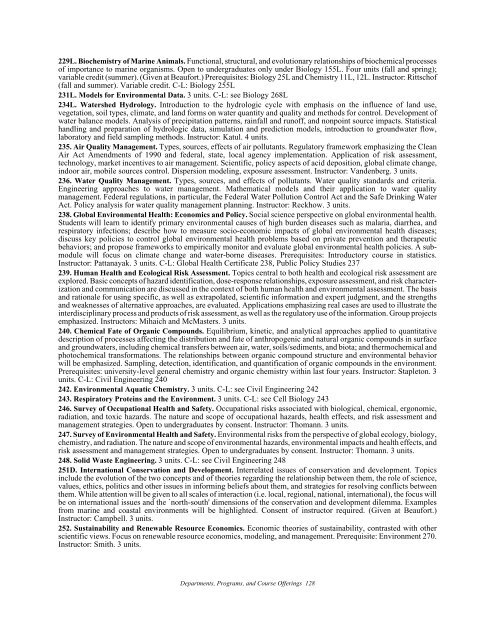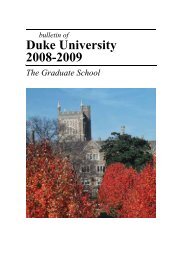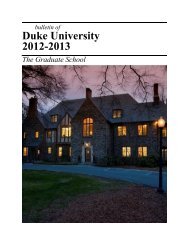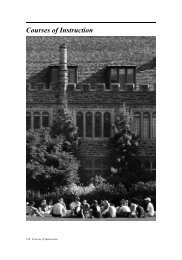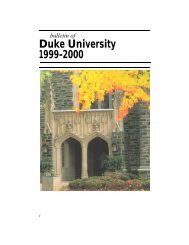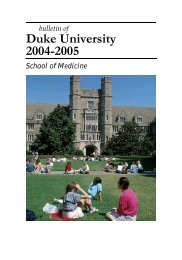Duke University 2009-2010 - Office of the Registrar - Duke University
Duke University 2009-2010 - Office of the Registrar - Duke University
Duke University 2009-2010 - Office of the Registrar - Duke University
You also want an ePaper? Increase the reach of your titles
YUMPU automatically turns print PDFs into web optimized ePapers that Google loves.
229L. Biochemistry <strong>of</strong> Marine Animals. Functional, structural, and evolutionary relationships <strong>of</strong> biochemical processes<br />
<strong>of</strong> importance to marine organisms. Open to undergraduates only under Biology 155L. Four units (fall and spring);<br />
variable credit (summer). (Given at Beaufort.) Prerequisites: Biology 25L and Chemistry 11L, 12L. Instructor: Rittsch<strong>of</strong><br />
(fall and summer). Variable credit. C-L: Biology 255L<br />
231L. Models for Environmental Data. 3 units. C-L: see Biology 268L<br />
234L. Watershed Hydrology. Introduction to <strong>the</strong> hydrologic cycle with emphasis on <strong>the</strong> influence <strong>of</strong> land use,<br />
vegetation, soil types, climate, and land forms on water quantity and quality and methods for control. Development <strong>of</strong><br />
water balance models. Analysis <strong>of</strong> precipitation patterns, rainfall and run<strong>of</strong>f, and nonpoint source impacts. Statistical<br />
handling and preparation <strong>of</strong> hydrologic data, simulation and prediction models, introduction to groundwater flow,<br />
laboratory and field sampling methods. Instructor: Katul. 4 units.<br />
235. Air Quality Management. Types, sources, effects <strong>of</strong> air pollutants. Regulatory framework emphasizing <strong>the</strong> Clean<br />
Air Act Amendments <strong>of</strong> 1990 and federal, state, local agency implementation. Application <strong>of</strong> risk assessment,<br />
technology, market incentives to air management. Scientific, policy aspects <strong>of</strong> acid deposition, global climate change,<br />
indoor air, mobile sources control. Dispersion modeling, exposure assessment. Instructor: Vandenberg. 3 units.<br />
236. Water Quality Management. Types, sources, and effects <strong>of</strong> pollutants. Water quality standards and criteria.<br />
Engineering approaches to water management. Ma<strong>the</strong>matical models and <strong>the</strong>ir application to water quality<br />
management. Federal regulations, in particular, <strong>the</strong> Federal Water Pollution Control Act and <strong>the</strong> Safe Drinking Water<br />
Act. Policy analysis for water quality management planning. Instructor: Reckhow. 3 units.<br />
238. Global Environmental Health: Economics and Policy. Social science perspective on global environmental health.<br />
Students will learn to identify primary environmental causes <strong>of</strong> high burden diseases such as malaria, diarrhea, and<br />
respiratory infections; describe how to measure socio-economic impacts <strong>of</strong> global environmental health diseases;<br />
discuss key policies to control global environmental health problems based on private prevention and <strong>the</strong>rapeutic<br />
behaviors; and propose frameworks to empirically monitor and evaluate global environmental health policies. A submodule<br />
will focus on climate change and water-borne diseases. Prerequisites: Introductory course in statistics.<br />
Instructor: Pattanayak. 3 units. C-L: Global Health Certificate 238, Public Policy Studies 237<br />
239. Human Health and Ecological Risk Assessment. Topics central to both health and ecological risk assessment are<br />
explored. Basic concepts <strong>of</strong> hazard identification, dose-response relationships, exposure assessment, and risk characterization<br />
and communication are discussed in <strong>the</strong> context <strong>of</strong> both human health and environmental assessment. The basis<br />
and rationale for using specific, as well as extrapolated, scientific information and expert judgment, and <strong>the</strong> strengths<br />
and weaknesses <strong>of</strong> alternative approaches, are evaluated. Applications emphasizing real cases are used to illustrate <strong>the</strong><br />
interdisciplinary process and products <strong>of</strong> risk assessment, as well as <strong>the</strong> regulatory use <strong>of</strong> <strong>the</strong> information. Group projects<br />
emphasized. Instructors: Mihaich and McMasters. 3 units.<br />
240. Chemical Fate <strong>of</strong> Organic Compounds. Equilibrium, kinetic, and analytical approaches applied to quantitative<br />
description <strong>of</strong> processes affecting <strong>the</strong> distribution and fate <strong>of</strong> anthropogenic and natural organic compounds in surface<br />
and groundwaters, including chemical transfers between air, water, soils/sediments, and biota; and <strong>the</strong>rmochemical and<br />
photochemical transformations. The relationships between organic compound structure and environmental behavior<br />
will be emphasized. Sampling, detection, identification, and quantification <strong>of</strong> organic compounds in <strong>the</strong> environment.<br />
Prerequisites: university-level general chemistry and organic chemistry within last four years. Instructor: Stapleton. 3<br />
units. C-L: Civil Engineering 240<br />
242. Environmental Aquatic Chemistry. 3 units. C-L: see Civil Engineering 242<br />
243. Respiratory Proteins and <strong>the</strong> Environment. 3 units. C-L: see Cell Biology 243<br />
246. Survey <strong>of</strong> Occupational Health and Safety. Occupational risks associated with biological, chemical, ergonomic,<br />
radiation, and toxic hazards. The nature and scope <strong>of</strong> occupational hazards, health effects, and risk assessment and<br />
management strategies. Open to undergraduates by consent. Instructor: Thomann. 3 units.<br />
247. Survey <strong>of</strong> Environmental Health and Safety. Environmental risks from <strong>the</strong> perspective <strong>of</strong> global ecology, biology,<br />
chemistry, and radiation. The nature and scope <strong>of</strong> environmental hazards, environmental impacts and health effects, and<br />
risk assessment and management strategies. Open to undergraduates by consent. Instructor: Thomann. 3 units.<br />
248. Solid Waste Engineering. 3 units. C-L: see Civil Engineering 248<br />
251D. International Conservation and Development. Interrelated issues <strong>of</strong> conservation and development. Topics<br />
include <strong>the</strong> evolution <strong>of</strong> <strong>the</strong> two concepts and <strong>of</strong> <strong>the</strong>ories regarding <strong>the</strong> relationship between <strong>the</strong>m, <strong>the</strong> role <strong>of</strong> science,<br />
values, ethics, politics and o<strong>the</strong>r issues in informing beliefs about <strong>the</strong>m, and strategies for resolving conflicts between<br />
<strong>the</strong>m. While attention will be given to all scales <strong>of</strong> interaction (i.e. local, regional, national, international), <strong>the</strong> focus will<br />
be on international issues and <strong>the</strong> `north-south' dimensions <strong>of</strong> <strong>the</strong> conservation and development dilemma. Examples<br />
from marine and coastal environments will be highlighted. Consent <strong>of</strong> instructor required. (Given at Beaufort.)<br />
Instructor: Campbell. 3 units.<br />
252. Sustainability and Renewable Resource Economics. Economic <strong>the</strong>ories <strong>of</strong> sustainability, contrasted with o<strong>the</strong>r<br />
scientific views. Focus on renewable resource economics, modeling, and management. Prerequisite: Environment 270.<br />
Instructor: Smith. 3 units.<br />
Departments, Programs, and Course Offerings 128


